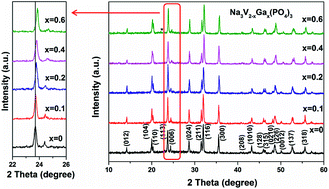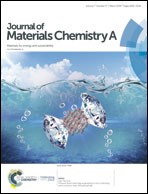In situ catalytic formation of graphene-like graphitic layer decoration on Na3V2−xGax(PO4)3 (0 ≤ x ≤ 0.6) for ultrafast and high energy sodium storage†
Abstract
A series of Na3V2−xGax(PO4)3 (x = 0, 0.1, 0.2, 0.4 and 0.6) with in situ catalytic formation of graphene-like graphitic layer decoration are synthesized via a solid-state reaction process. It is shown for the first time that the substitution of gallium for vanadium in Na3V2−xGax(PO4)3 (x = 0.1, 0.2, 0.4 and 0.6) enhances its energy density by about 4.4% (from 355.5 W h kg−1 for Na3V2(PO4)3 to 371 W h kg−1 for Na3V1.6Ga0.4(PO4)3) and particularly increases significantly its power density to up to 11 075 W kg−1 at 50C for Na3V1.6Ga0.4(PO4)3 compared to 5060 W kg−1 for Na3V2(PO4)3. The optimal composition Na3V1.6Ga0.4(PO4)3 is able to deliver a reversible capacity of 96.3 mA h g−1 at 30C and 80.6 mA h g−1 at 50C. After 1000 cycles at 5C, the reversible capacity of the Na3V1.6Ga0.4(PO4)3 electrode can still reach 101.1 mA h g−1 with a capacity retention of 97.3% (a very slow capacity decay of 0.0027% per cycle). These excellent electrochemical performances can be attributed largely to the highly graphitic carbon coating. Combining the analyses of transmission electron microscopy and Raman spectroscopy, it can be concluded that the Ga-doping in this series of electrode materials increases the proportion of sp2-type carbon. The development of these Na3V2−xGax(PO4)3 powders provides a promising cathode material for high power sodium-ion batteries.



 Please wait while we load your content...
Please wait while we load your content...